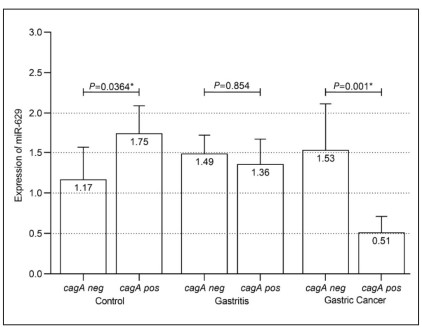HIGHLIGHTS
- Gastric cancer is associated with a drastic decrease in the expression of miR-629, a mechanism that may affect gastric carcinogenesis.
- The H. pylori virulence marker, cagA gene, somehow appears to modulate the expression of miR-629.
- The cagA gene, is associated with an intense reduction in the expression of miR-629 in gastric cancer samples.
ABSTRACT – Background –
Helicobacter pylori (H. pylori) is a gram-negative bacterium associated with the etiology of several gastrointestinal tract pathologies, and cagA-positive (cagA+) strains are found in populations with gastric ulcers and precancerous lesions, inducing pro-inflammatory responses. The development of neoplasms is related to microRNA (miRNA) dysregulation, indicating highly expressed miRNA-629. The article aims to correlate the expression level of miRNA-629 with the presence of H. pylori and the pathogenicity marker cagA. Methods – 203 gastric biopsy samples were evaluated from individuals with normal gastric tissue (n=60), gastritis (n=96), and gastric cancer (n=47) of both genders and over 18 years old. The samples were subdivided according to the presence or absence of H. pylori, detected by polymerase chain reaction (PCR). RNA was extracted using a commercial kit and quantified. Complementary DNA (cDNA) was synthesized using commercial kits, and the relative expression was calculated using the 2-ΔΔCt method. Results – Individuals infected with H. pylori are nine times more likely to develop gastric cancer. Cancer patients appeared to have decreased expression of miRNA-629; however, the presence of the bacterium would not influence this reduction. Individuals in the cancer group showed lower miRNA-629 expression when cagA+; however, in the control group, the expression was higher when cagA+.
CONCLUSÃO
H. pylori is a factor involved in the etiology and progression of gastric diseases. Reduction in miRNA-629 expression in cancer patients occurs independent of the presence of the bacterium, but when the cagA pathogenicity marker is present, it induces changes in the gene expression of the respective miRNA.
AUTORES
Caroline dos Reis Rodrigues SOARES1, Lucas Matheus Vieira da SILVA1, Bianca Reis ALMEIDA1, Jéssica Nunes PEREIRA2, Mônica Pezenatto dos SANTOS3, Mônica Santiago BARBOSA4, Marília de Arruda Cardoso SMITH5, Spencer Luiz Marques PAYÃO1 and Lucas Trevizani RASMUSSEN1,6


